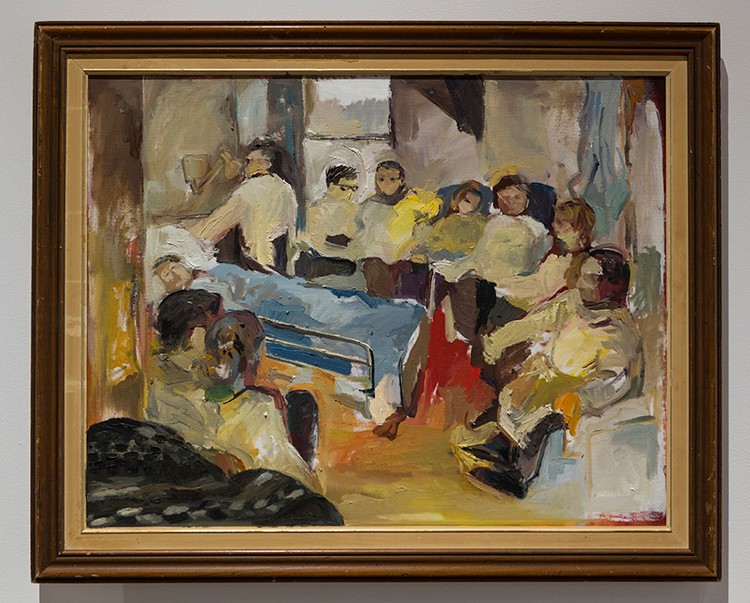COMBINE 2012: Annual Undergraduate Student Exhibition
Author: Clinton Glenn
Artist: Simon Larivière
 Simon Larivière, Encounter With Mythology, 2011, oil painting on framed canvas, 66.04 x 81.28 cm. Photo: Guy L'Heureux
Simon Larivière, Encounter With Mythology, 2011, oil painting on framed canvas, 66.04 x 81.28 cm. Photo: Guy L'Heureux
About the artist
Simon Larivière's Mythological Encounter presents the viewer with a deceptively simple hospital scene. The compositional space of the image is weighted towards figures surrounding a hospital bed in a semi-circle with the central focus on the bed itself. The viewer is located outside the hospital room, neither inside nor excluded from the scene. This viewpoint can also be directly related to the position of the artist himself, a distance between the event and the individuals therein. Looking closer, there is the tacit acknowledgement of an ability to access the pictorial space. An opening in the semi-circle leads the eye directly towards the focal point of the bed. However, one cannot actually enter this space: the viewer remains forever outside the hospital room, looking inwards.
When examining the figures themselves, this distance becomes more pronounced. Their bodies are relatively featureless, reduced to quick strokes of colour with minimal detail applied. The figures on the right-hand side form a continuous shape, melding together as one, save small slivers of colour that define their contours. One cannot readily identify these individuals; they could be anyone. We do not know these people, yet we sympathize with them and put ourselves in their place. However, with the knowledge that the painting was created in response to the death of the artist's grandmother, this division between subject and viewer is reinforced. The image implicates us in this communal event, yet refuses to reveal any intimate knowledge of the experience itself.
Larivière’s technique involves each stroke of the brush immediately reacting to the preceding one. This movement becomes automatic, closely tied to the idea of a flow of emotion directed from one's unconscious transmitted through continuous movement. The spontaneous nature of the painting points towards a larger concern for the artist, one in which a pure connection with emotion becomes the primary focus.
The canvas consists of an older painting that had been found in the garbage; the work was painted over it. This act of simultaneous creation and destruction mirrors the image of a person's final moments, their life being obscured by death's finality. However, if one looks close enough, small traces of the past still remain.
Larivière notes that the mythological encounter of the title suggests how links to the past were cut when his grandmother passed away. Real, historical links are erased, and only myths, imperfect memories are what remain. This notion of mythology also extends to the larger metaphor proffered by the work: death has become a mythological encounter, one in which familial history and shared experience intertwine with preconceptions of just what the final event should entail.
Biographies
Clinton Glenn
Clinton Glenn is a third-year Art History/Sexuality Studies student at Concordia University. His current research interests focus on curatorial and art-making practices that question the body in physical space through the intersecting categories of gender and sexuality. The goal of this interest lies in understanding the ways in which curators and artists manipulate space, in order to call into question how art and culture normalizes specific modes of being while marginalizing and silencing others. Glenn is also currently on the executive of the 2013 edition of the Art Matters Festival.
Simon Larivière
Simon Larivière is a 4th year undergrad at Concordia. He was born in Montreal where he still lives and works. Previously fauvist and member of the colorist school of Montreal, he now tries to ally the expression of the unconscious' vitality with the designing of more thoughtful compositions. Themes central to his work are the sensory experience and the questioning of the constructs of reality, spatial distorsions, lyrism, human relationships, painting itself and the everyday. The certain type of awkward coherence that emanates from this kind of piece escapes a full understanding but instead appeals to a feeling of mystery and wonder. His work may be considered as attempts to inscribe a shift in attitude towards our own psychee. By allowing the play between subject and experience to become looser and by letting the meaning sort of ‘float’, one may enter a more holistic- and meaningful experience through feeling.

